
Temperature Distribution on Earth & Heat Budget
Subscribe to Never Miss an Important Update! Assured Discounts on New Products!
Must Join PMF IAS Telegram Channel & PMF IAS History Telegram Channel
Last updated on April 25, 2024 1:10 PM
Temperature Distribution on Earth
- Sun is the ultimate source of heat. And the differential heat received from sun by different regions on earth is the ultimate reason behind all climatic features. So understanding the patterns of distribution of temperature in different seasons is important for understanding various climatic features like wind systems, pressure systems, precipitation etc..
Insolation
- Earth intercepts only one in two billion parts of solar radiation. This intercepted radiation is called Insolation.
- Insolation == Proportion of Solar energy received or intercepted by earth.
- Some heat within the core and mantle is transferred to the surface and ocean bottoms through volcanoes, springs and geysers. But this heat received at the surface form interiors of the earth is negligible compared to that received from sun.
- Earth receives Sun’s radiation (heat) in the form of short waves (visible light + wavelengths below visible light – most of it is ultraviolet radiation) which are of electromagnetic nature. The earth absorbs short wave radiation during daytime and reflects back the heat received into space as long-wave radiation (mostly infrared radiation) during night.

Ways of Transfer of Heat Energy
- The heat energy from the solar radiation is received by the earth through three mechanisms—
- Radiation == Heat transfer from one body to another without actual contact or movement. It is possible in relatively emptier space, for instance, from the sun to the earth through space.
- Conduction == Heat transfer through matter by molecular activity. Heat transfer in iron and other metals is by conduction. Generally, denser materials like water are good conductors and a lighter medium like air is a bad conductor of heat.
- Convection == Transfer of heat energy by actual transfer of matter or substance from one place to another. (heat transfer by convection cycles in atmosphere as well as oceans)
Factors Affecting Temperature Distribution
The Angle of Incidence or the Inclination of the Sun’s Rays
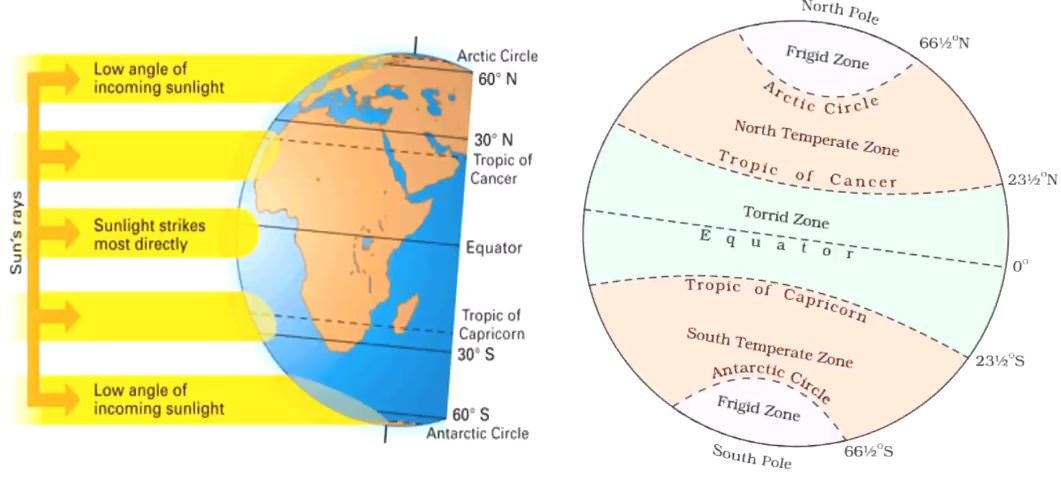
Duration of Sunshine
- Heat received depends on day or night; clear sky or overcast, summer or winter etc..
Transparency of Atmosphere
- Aerosols (smoke, sooth), dust, water vopour, clouds etc. effect transparency.
- If the wavelength (X) of the radiation is more than the radius of the obstructing particle (such as a gas), then scattering of radiation takes place.
- If the wavelength is less than the obstructing particle (such as a dust particle), then total reflection takes place.
- Absorption of solar radiation takes place if the obstructing particles happen to be water vapour, ozone molecules, carbon dioxide molecules or clouds.
- Most of the light received by earth is scattered light.

Land-Sea Differential
- Albedo of land is much greater than albedo of oceans and water bodies. Especially snow covered areas reflect up to 70%-90% of insolation.
- Average penetration of sunlight is more in water – up to 20 metres, than in land – where it is up to 1 metre only. Therefore, land cools or becomes hot more rapidly compared to oceans. In oceans, continuous convection cycle helps in heat exchange between layers keeping diurnal and annual temperature ranges low. (more while studying salinity and temperature distribution of oceans)
- The specific heat of water is 2.5 times higher than landmass, therefore water takes longer to get heated up and to cool down.
Prevailing Winds
- Winds transfer heat from one latitude to another. They also help in exchange of heat between land and water bodies.
- The oceanic winds have the capacity to take the moderating influence of the sea to coastal areas – reflected in cool summers and mild winters. This effect is pronounced only on the windward side (the side facing the ocean).
- The leeward side or the interiors do not get the moderating effect of the sea, and therefore experience extremes of temperature.
Aspects of Slope
- The direction of the slope and its angle control the amount of solar radiation received locally. Slopes more exposed to the sun receive more solar radiation than those away from the sun’s direct rays.
- Slopes that receive direct Sun’s rays are dry due to loss of moisture through excess evaporation. These slopes remain barren if irrigational facilities are absent. But slopes with good irrigational facilities are good for agriculture due to abundant sunlight available. They are occupied by dense human settlements.
- Slopes that are devoid of direct sunlight are usually well forested.

Ocean Currents
- Ocean currents influence the temperature of adjacent land areas considerably. (more while studying ocean currents).
Altitude
- With increase in height, pressure falls, the effect of greenhouse gases decreases and hence temperature decreases (applicable only to troposphere).
- The normal lapse rate is roughly 1⁰ C for every 165 metres of ascent.
Earth’s Distance form Sun
- During its revolution around the sun, the earth is farthest from the sun (152 million km on 4th July). This position of the earth is called
- On 3rd January, the earth is the nearest to the sun (147 million km). This position is called
- Therefore, the annual insolation received by the earth on 3rd January is slightly more than the amount received on 4th July.
- However, the effect of this variation in the solar output is masked by other factors like the distribution of land and sea and the atmospheric circulation.
- Hence, this variation in the solar output does not have great effect on daily weather changes on the surface of the earth.
Latitudinal Heat Balance
- The amount of insolation received varies from latitude to latitude.
- Regions within the equator and 40° N and S latitudes receive abundant sunlight and hence more heat will be gained than lost. Hence they are energy surplus regions.
- Regions beyond 40° N and S latitudes lose more heat than that gained from sunlight. Hence they are energy deficit regions (This is because of slant sunlight and high albedo of polar regions).
- Going by this logic, the tropics should have been getting progressively hotter and the poles getting progressively cooler. And the planet would have been inhospitable except for few regions near mid-latitudes. But, in reality, this does not happen.
- The atmosphere (planetary winds) and the oceans (ocean currents) transfer excess heat from the tropics (energy surplus region) towards the poles (energy deficit regions) making up for heat loss at higher latitudes.
- And most of the heat transfer takes place across the mid-latitudes (30° to 50°)[more while studding jet streams and cyclones], and hence much of the stormy weather is associated with this region.
- Thus, the transfer of surplus energy from the lower latitudes to the deficit energy zone of the higher latitudes, maintains an overall balance over the earth’s surface.


Heat Budget
- The earth receives a certain amount of Insolation (short waves) and gives back heat into space by terrestrial radiation (longwave radiation). Through this give and take, or the heat budget, the earth maintains a constant temperature.

Gif Image: Copy Paste and view in Power Point in Full screen Mode
The Mean Annual Temperature Distribution
- Isotherm == An imaginary line joining places having equal temperatures.
- The horizontal or latitudinal distribution of temperature is shown with the help of a map with isotherms.
- Effects of altitude is not considered while drawing an isotherm. All the temperatures are reduced to sea levels.
General characteristics of isotherms.
- Generally follow the parallels: Isotherms have close correspondence with the latitude parallels mainly because the same amount of insolation is received by all the points located on the same latitude.
- Sudden bends at ocean – continent boundaries: Due to differential heating of land and water, temperatures above the oceans and landmasses vary even on the same latitude. (we have seen how land sea differential effects temperature distribution)
- Narrow spacing between isotherms indicate rapid change in temperature (high thermal gradient).
- Wide spacing between isotherms indicate small or slow change in temperatures (low thermal gradient).
General Temperature Distribution
- The highest temperatures occur over tropics and sub-tropics (high insolation). The lowest temperatures occur in polar and sub polar regions. in continents due to the effect of continentiality.
- Diurnal and annual range of temperatures are highest in the interiors of continents due to the effect of continentiality (in continental interiors these will no moderating effect of oceans).
- Diurnal and annual range of temperatures are least in oceans. [high specific heat of water and mixing of water keep the range low]
- Low temperature gradients are observed over tropics (sun is almost overhead the entire year) and high temperature gradients over middle and higher latitudes (sun’s apparent path varies significantly from season to season).
- Temperature gradients are usually low over the eastern margins of continents. (This is because of warm ocean currents)
- Temperature gradients are usually high over the western margins of continents. (This is because of cold ocean currents)
- The isotherms are irregular over the northern hemisphere due to an enhanced land-sea contrast. Because of predominance of land over water in the north, the northern hemisphere is warmer. The thermal equator (ITCZ) lies generally to the north of geographical equator.
- While passing through an area with warm ocean currents, the isotherms show a poleward shift. (North Atlantic Drift and Gulf Stream combined with westerlies in Northern Atlantic; Kurishino Current and North Pacific current combined with westerlies in Northern Pacific) (we will see about ocean currents in detail later.)
- Mountains also affect the horizontal distribution of temperature. For instance, the Rockies and the Andes stop the oceanic influence from going inwards into North and South America.
Seasonal Temperature Distribution
- The global distribution of temperature can well be understood by studying the temperature distribution in January and July.
- The temperature distribution is generally shown on the map with the help of isotherms. The Isotherms are lines joining places having equal temperature.
- In general the effect of the latitude on temperature is well pronounced on the map, as the isotherms are generally parallel to the latitude. The deviation from this general trend is more pronounced in January than in July, especially in the northern hemisphere.
- In the northern hemisphere the land surface area is much larger than in the southern hemisphere. Hence, the effects of land mass and the ocean currents are well pronounced.
Seasonal Temperature Distribution – January
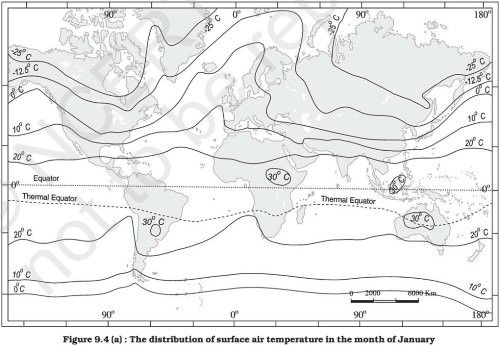
- During January, it is winter in the northern hemisphere and summer in the southern hemisphere.
- The western margins of continents are warmer than their eastern counterparts, since the Westerlies are able to carry high temperature into the landmasses.
- The temperature gradient is close to the eastern margins of continents. The isotherms exhibit a more regular behavior in the southern hemisphere.
Northern Hemisphere
- The isotherms deviate to the north over the ocean and to the south over the continent. This can be seen on the North Atlantic Ocean.
- The presence of warm ocean currents, Gulf Stream and North Atlantic drift, make the Northern Atlantic Ocean warmer and the isotherms show a poleward shift indicating that the oceans are warmer and are able to carry high temperatures poleward.
- An equator ward bend of the isotherms over the northern continents shows that the landmasses are overcooled and that polar cold winds are able to penetrate southwards, even in the interiors. It is much pronounced in the Siberian plain.
- Lowest temperatures are recorded over northern Siberia and Greenland.
Southern Hemisphere
- The effect of the ocean is well pronounced in the southern hemisphere. Here the isotherms are more or less parallel to the latitudes and the variation in temperature is more gradual than in the northern hemisphere.
- The high temperature belt runs in the southern hemisphere, somewhere along 30°S latitude.
- The thermal equator lies to the south of geographical equator (because the Intertropical Convergence Zone or ITCZ has shifted southwards with the apparent southward movement of the sun).
Seasonal Temperature Distribution – July

- During July, it is summer in the northern hemisphere and winter in the southern hemisphere. The isothermal behavior is the opposite of what it is in January.
- In July the isotherms generally run parallel to the latitudes. The equatorial oceans record warmer temperature, more than 27°C. Over the land more than 30°C is noticed in the subtropical continental region of Asia, along the 30° N latitude.
Northern Hemisphere
- The highest range of temperature is more than 60° C over the north-eastern part of Eurasian continent. This is due to continentiality. The least range of temperature, 3°C, is found between 20° S and 15° N.
- Over the northern continents, a poleward bend of the isotherms indicates that the landmasses are overheated and the hot tropical winds are able to go far into the northern interiors.
- The isotherms over the northern oceans show an equator ward shift indicating that the oceans are cooler and are able to carry the moderating effect into tropical interiors. The lowest temperatures are experienced over Greenland.
- The highest temperature belt runs through northern Africa, west Asia, north-west India arid southeastern USA. The temperature gradient is irregular and follows a zig-zag path over the northern hemisphere.
Southern Hemisphere
- The gradient becomes regular over the southern hemisphere but shows a slight bend towards the equator at the edges of continents. Thermal equator now lies to the north of the geographical equator.
Questions from NCERT
1. The atmosphere is mainly heated by the:
- Short wave solar radiation
- Long wave terrestrial radiation
- Reflected solar radiation
- Scattered solar radiation
2. The main reason that the earth experiences highest temperatures in the subtropics in the northern hemisphere rather than at the equator is:
- Subtropical areas tend to have less cloud cover than equatorial areas.
- Subtropical areas have longer day hours in the summer than the equatorial.
- Subtropical areas have an enhanced “greenhouse effect” compared to equatorial areas.
- Subtropical areas are nearer to the oceanic areas than the equatorial locations.
30 words
- How does the unequal distribution of heat over the planet earth in space and time cause variations in weather and climate?
- What are the factors that control temperature distribution on the surface of the earth?
- In India, why is the day temperature maximum in May and why not after the summer solstice?
- Why is the annual range of temperature high in the Siberian plains
150 words
- How do the latitude and the tilt in the axis of rotation of the earth affect the amount of radiation received at the earth’s surface?
- Discuss the processes through which the earth-atmosphere system maintains heat balance.
- Compare the global distribution of temperature in January over the northern and the southern hemisphere of the earth.
Primary References: NCERT Geography, Certificate Physical and Human Geography [Amazon and Flipkart] and Spectrum’s Geography [Amazon and Flipkart].
Last updated on April 25, 2024 1:10 PM





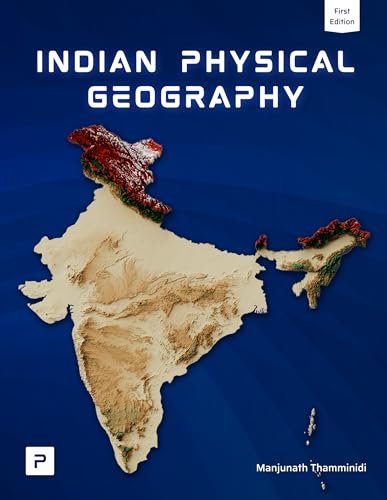

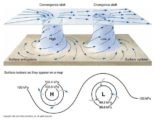


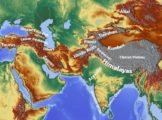



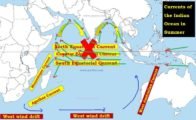




Is there any way you could come up with answers to ncert questions.. It would be better to cross check after we solve the question ..
Thanks for all information.. You have put really good efforts in creating the contents.. It must have taken months..
Sorry! I have little time to look beyond making notes on topics related to UPSC CSE.
No problem..
“If the wavelength (X) of the radiation is more than the radius of the obstructing particle (such as a gas), then scattering of radiation takes place.”
In this case the blue has short wavelength than red. so since red has high wavelength,that to be scattered more than blue.But that is not happening . why?? Could some one correct me ??
it is because the scattering rate is also inversly proportional to the 4th power of wavelength of em waves.
Sir itcz or thermal equator is same thing?
Yeah, they both mean the same.
The anwer of the second MCQ should be (a)? Please explain. Thanks in advance.
sir you also makes notes for economies gs paper please reply
No. Not for UPSC 2018.
Sir world geography notes is available r not i cant fint world geography note please reply
There is no separate notes on world Geography. World geography is intertwined into the existing concepts.
Why the annual range of temperature is high in the siberian plains ?
please sir explain it i don’t understand it’s answer.
Earth’s Distance form Sun. the aphelion and perihelion got cut off. i hope u fix them.
Earth’s Distance form Sun. the aphelion and perihelion got cut off. i hope u fix them.
Sir, on what factors does thermal equator depend, can variability of total solar insoltation be a factor ??
Sir all these topics which you have uploaded . Are they sufficient for mains and Prelim
Hello sir, are your pdf enough for geo optional? Please tell sir
I think wavelength part is somewhat wrong ??..It is written that the light with longer wavelength scatters and shorther wavelength reflects totally…is it correct ?..please notify me ..